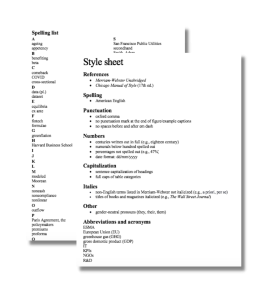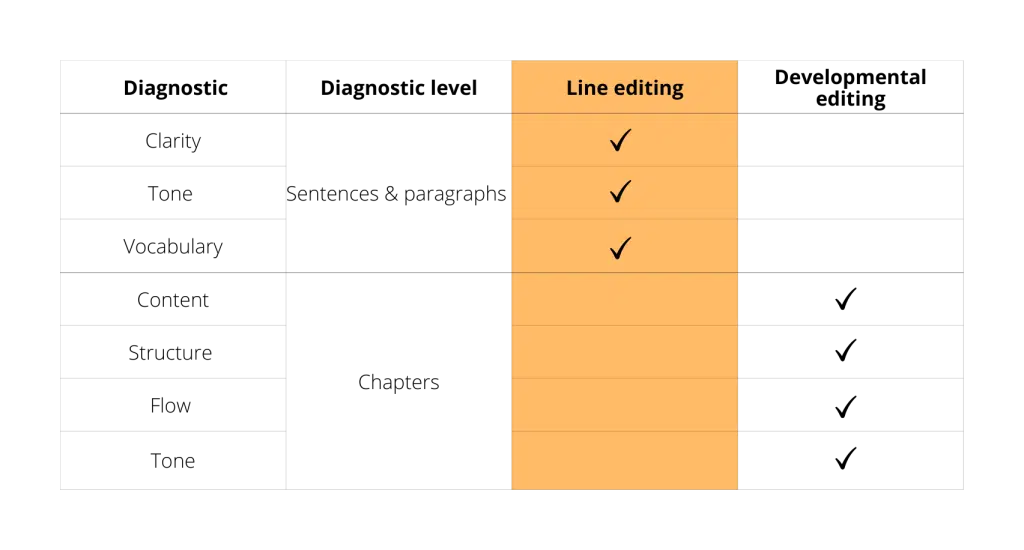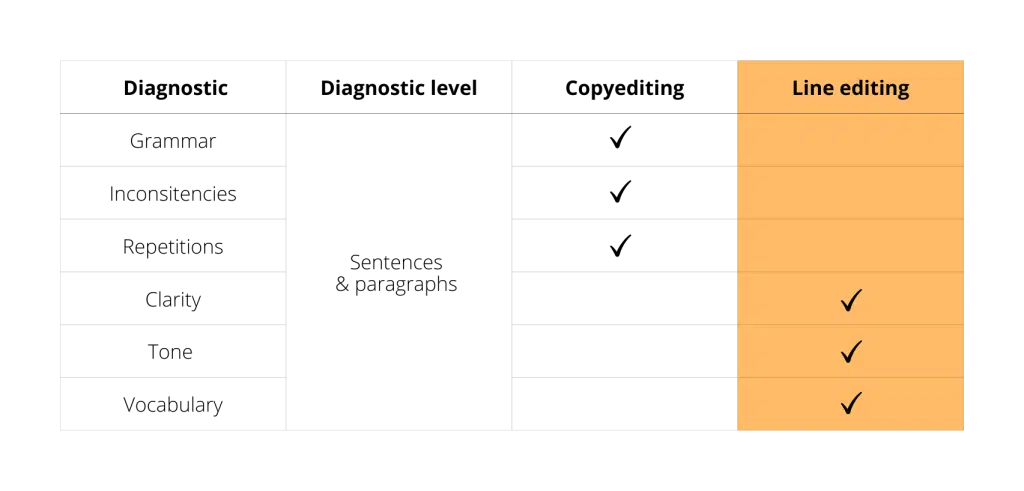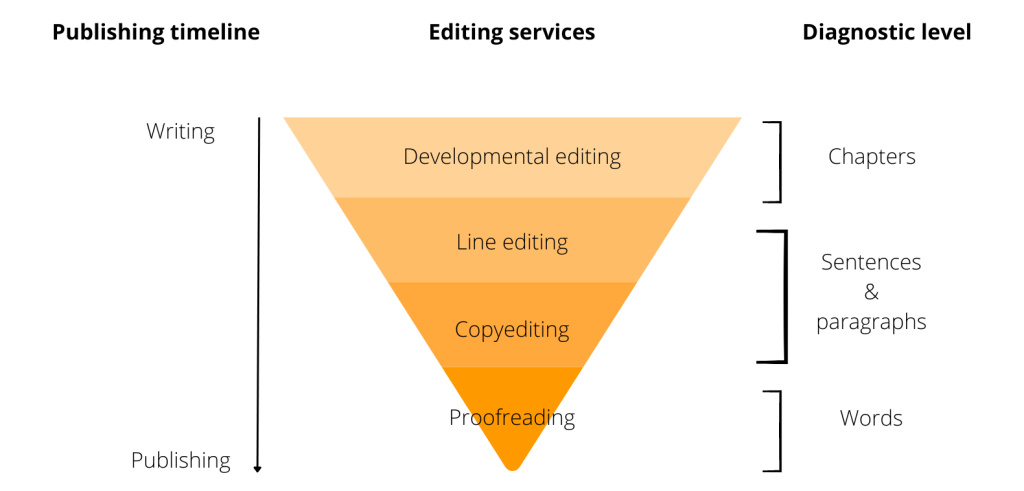Line editing involves an editor working line by line through your manuscript. It is a subtle process of discovering the words and rhythm that effectively tell your story and bring out your authentic authorial voice. Line editing aims at communicating your message and story, so they are clear and relevant to your target reader. The three most important elements of the text addressed during line editing are clarity, tone and vocabulary of your text. Line editing is one of the editorial processes that take place when preparing a text for publishing. After reading this text you will understand the fundamentals of line editing, how it differs from other editing services and how and when you should engage a line editor.
What is included? | What is not included? | Why hire an editor? | When hire an editor? | Before hiring an editor | Pricing | Timeline | Line editing vs developmental editing | Line editing vs copyediting | What next? | Other editing
Find the words and rhythm that effectively tell your story
Bring your authentic authorial voice to life
Improve clarity, tone and vocabulary
Diagnose tone shifts and flow issues
What does line editing include?
Line editing diagnoses issues with clarity, tone and vocabulary of each sentence and paragraph. In other words, it assesses whether your voice and message are conveyed in the best possible way for your intended reader. As a part of this service, the editor may bring to your attention the following:
- redundant words or sentences that can be tightened without jeopardising the message
- repetitions of the same information presented in slightly different ways
- vocabulary that may be unappealing or unnatural to your target reader
- abrupt changes in the narration due to a lack of transitions
- unintended shifts in tone and pacing
- phrasing or content that may be considered sensitive and thus should be conveyed accurately and respectfully
- phrases and sentences that reveal unintended bias
- digressions that do not contribute to developing the narration
 or argument
or argument - inconsistent style or tone
- any elements that may not resonate with the intended reader, such as jargon or slang.
A text that has undergone line editing should return to you as a marked-up manuscript with tracked changes and comments from the editor. It may be also accompanied by a style sheet. A style sheet lists choices governing your text, such as spelling and punctuation, to ensure consistency. It should also help in the following stages of preparing the text for publication, such as copyediting, when decisions about spelling and styling are finalised. It will then guide the proofreading to ensure the text is completely consistent. A style sheet may include decisions concerning spelling, capitalisation, punctuation and treatment of abbreviations or the point of view.
What is not included in line editing?
Line editing does not diagnose grammar, spelling, punctuation and formatting issues. These aspects are addressed in the editing services that come after line editing, namely, copyediting and proofreading. Likewise, the big-picture issues, such as those concerning flow, structure, tone and clarity of every chapter, but also themes and argument or plot developments, should have been finalised by the time the text undergoes line editing. These aspects are diagnosed in the preceding stage, during developmental editing.
Why should you hire a line editor?
The issues diagnosed during line editing, such as tightening sentences, adjusting the vocabulary, ensuring authenticity and consistency of the authorial voice, are difficult to self-edit. This is because, at that stage, you have probably become quite familiar with a text. As a result, you have likely lost objectivity and ability to detect opportunities for improvement, even more so, detect errors. For instance, you might lose sight of what each paragraph should convey. Or you might grow attached to particular expressions even if they do not add value; you might not notice a tendency to use to start the paragraphs in the same way or use repetitive vocabulary. These are just some examples of tasks that a line editor will perform to make sure that every word, sentence and paragraph its weight.
When should you hire a line editor?
Your text is ready for line editing after friends, family and beta readers have read it and all the ‘big-picture’ uses have been resolved (such as plot line or argumentation sequence addressed during developmental edit). For line editing to be effective, your argument/plot, perspective, structure (sequencing) and key ideas and themes must be finalised. Only then will line editing be able to bring out your voice by addressing clarity, vocabulary and tone.
What should you consider when hiring a line editor?
It is crucial to find a line editor who can understand the needs of your text and who has prior experience working with the genre of your text. You can also request a sample edit ensure that they are a right fit for your text. They should get bonus points if they are a member of a professional editorial body, which means they are likely to have received formal training and follow a code of practice.
Ask if the line editor can do a sample edit
Editors may have different processes, but a sample edit is always a good way to start. It helps the editor understand the level of editorial intervention required and estimate time and cost. For you, it will provide an idea of how they will approach editing your text. Above all, carrying out a sample edit before signing a contract ensures that both parties have the same expectations and understand what work will be undertaken.
Check what the editor reads and edits the most
Find out what is the editor’s specialism. Knowing what genre they read and edit most often will tell you if line editing the genre represented by your text is within their skillset. Furthermore, examples of their past work and clients’ testimonials will demonstrate a track record of working with the genre of your choice. This will be a good reassurance that the editor will be able to deliver a valuable service.
Find out about the editor’s qualifications
Language is not a static monolith. It evolves with our culture, society, science and technology, changing and developing over time. For this reason, editors must not neglect their professional development to stay up-to-date with their domain. Joining a professional body offering training is one of the ways that line editors can do that. Global organisations for editors, such as the Editorial Freelancers Association (EFA), offer such opportunities. Regionally, in the UK, there is the Chartered Institute of Editing and Proofreading (CIEP). In North America, among others, there are ACES: The Society for Editing and the Northwest Editors Guild. So when hiring a line editor, it might be worth checking if they are a member of any accredited organisations.
How much should you pay for line editing?
The current hourly rates suggested by the CIEP for line editing start from £41.10. The EFA recommends line editing rates between $40 and $75 per hour, depending on the type of the text. Hourly rates in this region will be quoted by professional editors who can justify them with their expertise, training and experience. If you receive a lower estimation for line editing, the service might likewise represent a lower quality of editing.
But what goes into the editor’s pay is more than what meets the eye. Besides actually editing and writing editorial reports, for instance, they first read the entire text to be able to apply consistency of tone, voice and style to smaller units of text such as sentences and paragraphs. This is because although line editing is performed on the level of sentences and paragraphs, they are not analysed in isolation.
Likewise, the editor must simultaneously record any decisions they make and suggestions for improvement to be conveyed to the author. They usually also keep separate notes that they consult if the client has any questions about their edits. This is because every editorial intervention in a text should be intentional and justifiable. It is unacceptable if the editor you work with cannot defend the changes they introduced with the support of relevant references, such as a style guide or dictionary, language localisation or other relevant and recognised convention.
How long does line editing take?
We can estimate the pace of line editor’s work based on the type of the edited text. The EFA suggests that a line editor can edit 3–8 pages per hour. For instance, editing a fiction text may yield 5–8 pages per hour, while editing non-fiction — 4–7 pages. Editors Canada assess that line editing of a difficult text takes 1–2 pages per hour. However, editing a standard text may yield 2–3 edited pages per hour.
What is the difference between line editing and developmental editing?
Developmental editing is the most in-depth editorial review and critique of the text. It analyses how your text fits within the genre, its structure, plot line, characters, point of view or theme, argumentation and hypothesis. Line editing diagnoses issues on the sentence and paragraph level, while developmental editing takes a bird-view perspective, addressing potential issues on a chapter level. Thus, line editing takes after developmental editing; it may be performed by the same editor, depending on their skill set.
If we compare editing to a process of filtering water, developmental editing fishes out larger bits of debris, while line editing acts as a more subtle filter catching smaller but still undesired elements. Both should be performed to maximise the filtration efficiency and achieve the best possible quality of the text.

What is the difference between line editing and copyediting?
Copyediting takes place after line editing, and it works closely with grammar and spelling and addresses language and styling inconsistencies. Line editing ensures that your plot line or argument is conveyed in the clearest and most appealing way possible. Next, a copyedit should occur when you are happy with your argument but want to polish the language. One similarity is that both services work with sentences and paragraphs. However, copyediting is more granular, checking for consistency and correctness of language. On the other hand, line editing takes place on a more macro level. This because they aim to ensure your voice as an author speaks clearly to your target reader.
Both services also partake in creating the style sheet. A style sheet carries the complete record of the language and styling decisions to ensure clarity and consistency of the text. 
What should happen to your text after line editing?
Line editing is one of many processes that prepare the text for publication. So it may not be the only type of editing your text will need. It takes place after developmental editing and before copyediting and proofreading. The last step, proofreading, is the final check ensuring that the text is correct and consistent. Proofreading also addresses formatting and layout, thus preparing the text for typesetting. It is a light-touch intervention. Thus, at the stage when the text undergoes proofreading, there should be no significant changes or rewriting taking place.
Can a line editor do other types of editing?
Yes and no. Yes — many editors can perform different editorial services. So when considering employing a line editor to carry out another editorial service, find out their competencies. For the same reason, the answer may be ‘no.’ They might not be trained to carry out those more granular processes, like copyediting and proofreading. Another reason could be that the more one works with a text, the more one becomes familiar with it. Thus, it might be challenging for the same editor to offer a fresh eye when doing another round of editing on the same text.



